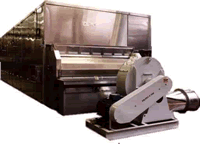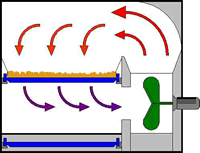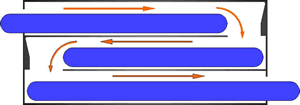Conveyor drying uses a perforated belt to transfer feed materials through the dryer. Heated air is either passed under and through, or over and through the belt and product bed before being reheated and re-circulated. Units are normally multi zoned and may have differing airflow's in successive zones. Additionally each zone may use a different temperature profile and control. Saturated or close to saturated air is exhausted from the dryer via a central exhaust duct.
Conveyor dryers may be multi pass units, in which the feed is transferred from one belt to another belt below it by gravity. These dryers are usually two or three pass machines. Additionally certain conveyor dryers, such as those used in vegetable dehydration have multiple belts in line, and the feed is transferred from one belt to another.
Feeding / discharge Manual, batch, automatic and continuous. Vibrators, oscillating feeders, gravity chutes Feed Characteristics Large granules, agglomerates, pellets, preformed (extruded) products (pressure agglomerates), small solid particles, large solid particles, agricultural products. Low to high feed rates
Heat Source Steam, electrical, coal, liquid fuels, or gas Exposure Mostly Direct. Flow can be through the bed (under to over, over to under, or both), cross, counter current or cocurrent. Indirect systems available for certain products. Residence time Highly Controllable. Residence time can be altered by varying the feed and discharge rates affecting the bed depth. Belt can be slowed and modulated.
Extraction Normally central induced. Re-circulating fans used in each zone.
Exhaust connected to common header
Dust Collection
Typically little required. For fine product a central bag house is sometimes used.
The Sakav Continuous Seal Steam Tube Dryer offers tremendous advantages for solvent extraction or drying in an inert gas atmosphere. The CS unit's revolutionary design permits material to be processed in a positive or negative pressure atmosphere and alleviates product and gas leakage into or out of the dryer.
Control
PLC control for each zone, infrequently solid state controllers.
System controls on above bed temperature. Can modulate energy.
Benefits
Very intimate contact with air/gas stream
Good for heat sensitive products and products requiring long residence times
Energy efficient due to recycling of process air Multiple zones offer flexibility for temperature and process control
Excellent transfer of energy
Can vary flows between zones
Gentle handling of product
Self contained with distributed foundation loading
Unit can have integral cooling section.
Limitations
High temperature units can be troublesome
Heater can clog on carryover
Belt tracking can be problematic
Belt may clog, requires frequent cleaning
Loss of fimes through perforations on flights or belt
The following range of Conveyor Machines, are available for the drying, Cooling and Curing of a wide range of product types-
Single pass (the product travels through the machine once only) Single stage machine (the product travels through the machine on one conveyor). Single pass machines have the advantage of being able to be set up with a temperature profile to match the different phases which a material will go through during processing. The most widely used type of conveyor machine.
Variation on the Single conveyor dryer principle, but using much higher air pressure and velocity, through a high resistance conveyor, has advantages in some applications.
Mainly used for the drying/curing of sheet products, after a coating process. A slower alternative to nozzle drying/curing which suits certain applications.


All of the advantages of single pass with the added advantage of multistaging, in which at intervals to suit the product, it is transferred from one conveyor to the next, which re-orients the product and allows deeper beds to be used later in the process, making effective use of available space. Especially suitable for very large tonnage machines.
Multipass: In this type of machine, the product travels the length of the machine more than once, traveling back on itself several times. This type of machine has the disadvantage that it cannot be set-up with a true temperature profile, but as it has sevaral conveyors on top of each other, the dwell can be several times longer than the equivalent single stage machine. Suitable for products which need gentle drying for long dwell times. For drying machines operating from high intitial moisture contents, multiple plenum chambers must be used, to limit the large temperatue drops inherent with this type of machine

